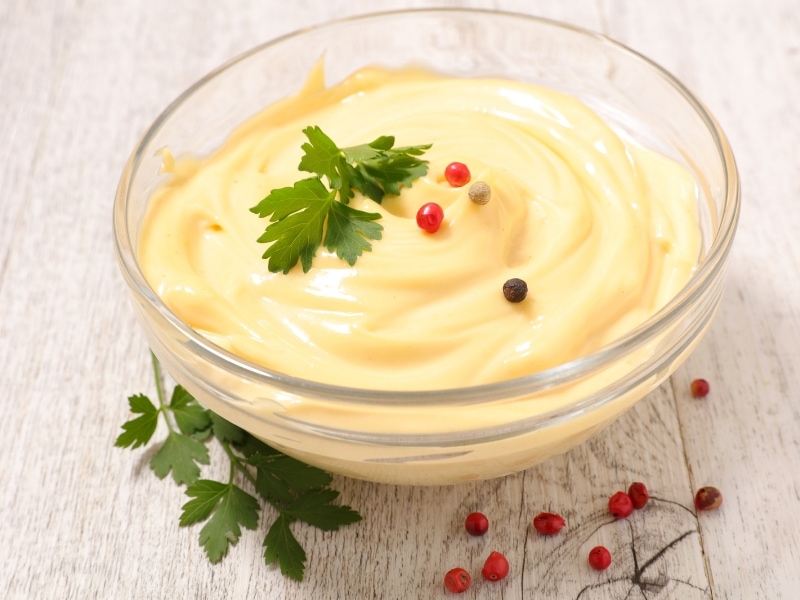A single tablespoon of mayonnaise provides roughly 90 calories. Furthermore, it contains 10 grams of total fat. Of those 10 grams, 1.5 grams comes from saturated fat. Additionally, there is 70 milligrams of sodium per serving.
To break it down, for every tablespoon you use, you are getting 90 calories of energy. Not only that, but 10 full grams of fat. Among the fats, 1.5 grams is saturated which is important to watch. Finally, on top of the calories and fats, there is also 70mg of sodium.
Homemade Mayonnaise Ingredients
1 whole egg
1/2 tablespoon lemon juice or vinegar
1 teaspoon Dijon mustard
1/4 teaspoon salt
3/4 cup neutral-flavored oil, such as canola, grapeseed, or safflower oil
How To Make Homemade Mayonnaise
Get your ingredients and tools ready. You will need 1 egg, 1/2 tablespoon lemon juice or vinegar, 1 teaspoon Dijon mustard, 1/4 teaspoon salt, and 3/4 cup neutral oil. You can use an immersion blender or food processor.
If using an egg straight from the fridge, let it sit in warm water for a few minutes to bring it to room temperature. This is important so the mayonnaise emulsifies properly.
Add the egg, lemon juice/vinegar, mustard, and salt to your food processor or mixing jar. Starting the emulsion is key, so process or blend these ingredients for 20 seconds or so.
With the food processor running or immersion blender on, slowly drizzle in the oil. Go slowly at first so the mixture can incorporate the oil droplets. Once about a quarter of the oil is added, it will start to thicken.
Continue adding the remaining oil in a steady stream, processing or blending the whole time. This allows the oil and other ingredients to blend into a smooth, creamy mayonnaise.
Taste and adjust seasoning by adding more salt if desired. The flavor will develop more over time.
Transfer the freshly made mayonnaise to an airtight container. You can store it in the fridge for up to a week. Enjoy your homemade mayo!
How to Make Mayonnaise in a Blender
Making homemade mayonnaise in a blender is quick, easy, and foolproof. The key is slowly adding oil while blending to achieve the perfect creamy consistency.
Ingredients
- 1 egg (preferably pasteurized)
- 1 cup neutral oil (such as canola, avocado, or sunflower oil)
- 1 tablespoon lemon juice or white vinegar
- 1 teaspoon Dijon mustard
- ½ teaspoon salt
Instructions
Blend the Egg, Mustard & Acid – In a blender or food processor, add the egg, lemon juice (or vinegar), mustard, and salt. Blend for 10-15 seconds until combined.
Slowly Drizzle in Oil – With the blender running on low speed, slowly pour in the oil in a thin, steady stream. This is essential for proper emulsification.
Watch It Thicken – As the oil is added, the mixture will thicken into a creamy mayonnaise.
Adjust & Store – Taste and adjust salt or acidity as needed. Store in an airtight container in the fridge for up to a week.
Tips for Perfect Blender Mayonnaise
✔ Use room temperature ingredients for best emulsification.
✔ Pour oil slowly to prevent the mayo from breaking.
✔ If the mayonnaise is too thin, blend longer or add more oil gradually.
How to Make Mayonnaise Without Egg
For those who are vegan, allergic to eggs, or looking for a lighter alternative, egg-free mayonnaise is an excellent option.
Ingredients for Vegan Mayonnaise
- ½ cup unsweetened soy milk or aquafaba (chickpea water)
- 1 cup neutral oil (avocado or sunflower oil)
- 1 tablespoon apple cider vinegar or lemon juice
- 1 teaspoon Dijon mustard
- ½ teaspoon salt
Instructions
Blend the Liquid Base – In a blender or food processor, combine soy milk (or aquafaba), vinegar, mustard, and salt. Blend for 10-15 seconds.
Slowly Add Oil – With the blender running on low, slowly pour in the oil in a steady stream.
Whisk Until Thick – As you add oil, the mixture will thicken into a creamy consistency.
Adjust & Store – Taste and adjust seasoning, then transfer to a jar and refrigerate.
Why This Works
Soy milk or aquafaba acts as an emulsifier, just like egg yolks.
Mustard and vinegar help create stability and enhance flavor.
✔ Egg-free & Vegan-friendly
✔ Dairy-free & Gluten-free
✔ Same creamy texture as traditional mayo
Is Mayonnaise Healthy?
The healthiness of mayonnaise depends on the ingredients used.
1. Calories & Fat Content
Traditional mayonnaise is high in fat and calories (about 90-100 calories per tablespoon).
Homemade versions allow you to choose healthier oils, making it a better option than store-bought mayo with preservatives and additives.
2. Healthy Mayonnaise Options
Use avocado oil or olive oil instead of processed vegetable oils.
Opt for egg-free mayo if you have dietary restrictions.
Add probiotics (such as yogurt-based mayo) for gut health benefits.
3. Is It Good for Weight Loss?
Mayonnaise is calorie-dense, so it should be consumed in moderation.
Using Greek yogurt or blended avocado can be a lower-calorie alternative.
✔ Homemade mayo is healthier than store-bought, but it should be eaten in moderation.
Homemade Mayonnaise FAQs
1. Why is my homemade mayonnaise too thin?
If your mayo is runny, it may not have emulsified properly. Try:
Adding more oil slowly while blending.
Using a fresh egg yolk and blending again.
Refrigerating to thicken.
2. How long does homemade mayonnaise last?
With eggs: 5-7 days in the refrigerator.
Egg-free mayo: Up to 2 weeks in the refrigerator.
Always store in an airtight container to maintain freshness.
3. Can I use olive oil for homemade mayonnaise?
Yes, but use light olive oil to avoid bitterness.
Extra virgin olive oil may create a strong, overpowering taste.
4. What’s the best substitute for eggs in mayonnaise?
Aquafaba (chickpea water)
Soy milk or almond milk
Cashews blended with water
5. Can I make mayonnaise without mustard?
Yes, but mustard helps stabilize emulsification.
You can substitute it with a pinch of turmeric or a little extra vinegar.

